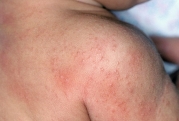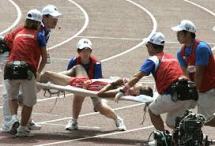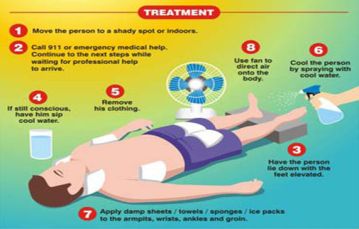Hyperthermia or high body temperature can develop rapidly with rising mercury levels under direct sun or in extremely hot environments such as when someone is left inside a car in the summer heat or in small spaces where the ventilation is poor, such as attics or boiler rooms.
Generally, our nervous system is responsible for maintaining healthy body temperature (97°F or 36.1°C – 99°F or 37.2°C). Whenever there is a rise in our body temperature, it tries to maintain this normal range by transferring heat through sweating and blood flow to the skin (thermoregulation), thus keeping our bodies cool.
Heat-Related illness is a medical condition that occurs when our bodies can no longer transfer enough heat. Even short periods of high temperatures can cause serious health problems.
High temperature caused by fever is different from a high body temperature caused by a heat-related illness. A fever is the body’s normal reaction to infection and other conditions, both minor and serious, while heat-related illnesses produce a high body temperature because the body cannot transfer heat effectively or the external heat gain is excessive.
As little as 1% decrease in body weight due to fluid loss can cause cardiovascular stress, causing a rapid heart rate and a decrease in the ability to transfer heat.
Types and Presentations of Heat-Related Illnesses
Heat-related illnesses range from those that cause temporary discomfort to the generally fatal heatstroke. The following checklist can help you identify yours:
 Heat Rash – A prickly skin irritation caused by excessive sweating during hot, humid weather.
Heat Rash – A prickly skin irritation caused by excessive sweating during hot, humid weather.  Most common in young children, it can also occur when the sweat ducts to the skin become blocked or swell. The rash looks like a red cluster of pimples or small blisters.
Most common in young children, it can also occur when the sweat ducts to the skin become blocked or swell. The rash looks like a red cluster of pimples or small blisters.
Heat cramps – A person who has been exercising or doing any other strenuous activity in the heat may develop painful muscle spasms in the arms, legs, or abdomen referred to as heat cramps. They result from sweating as it causes the body to lose water, salt, and minerals (electrolytes). Body temperature is usually normal, and the skin remains moist and cool, but sweaty.
 Heat edema (swelling) – in the legs and hands, which can occur when you sit or stand for a long time in a hot environment.
Heat edema (swelling) – in the legs and hands, which can occur when you sit or stand for a long time in a hot environment.
 Heat syncope (fainting) – sudden dizziness or fainting after exposure to high temperatures, particularly after exercising in the heat. It occurs from a sudden drop in blood pressure when heat causes the blood vessels to dilate and body fluids move into the legs because of gravity. The skin is pale and sweaty but remains cool. The pulse may be weak with a rapid heart rate. Body temperature is normal.
Heat syncope (fainting) – sudden dizziness or fainting after exposure to high temperatures, particularly after exercising in the heat. It occurs from a sudden drop in blood pressure when heat causes the blood vessels to dilate and body fluids move into the legs because of gravity. The skin is pale and sweaty but remains cool. The pulse may be weak with a rapid heart rate. Body temperature is normal.
 Heat exhaustion – generally happens when a person working or exercising in hot weather does not drink enough liquids to replace the lost fluids. It’s a warning that the body is getting too hot. Elderly people and people with high blood pressure are the most prone. A person with heat exhaustion may be thirsty, giddy, weak, uncoordinated, nauseous, and sweating profusely. Body temperature is usually normal, the pulse rate can be normal or elevated and the skin is cold and clammy.
Heat exhaustion – generally happens when a person working or exercising in hot weather does not drink enough liquids to replace the lost fluids. It’s a warning that the body is getting too hot. Elderly people and people with high blood pressure are the most prone. A person with heat exhaustion may be thirsty, giddy, weak, uncoordinated, nauseous, and sweating profusely. Body temperature is usually normal, the pulse rate can be normal or elevated and the skin is cold and clammy.
 Heatstroke (sunstroke) – occurs when the body fails to regulate its own temperature and it continues to rise, often to 105°F (40.6°C) or higher. In addition, there may be confusion, disorientation, bizarre behavior with a faint feeling, staggering, strong rapid pulse, dry flushed skin, and an absolute lack of sweating. Delirium or coma may also ensue.
Heatstroke (sunstroke) – occurs when the body fails to regulate its own temperature and it continues to rise, often to 105°F (40.6°C) or higher. In addition, there may be confusion, disorientation, bizarre behavior with a faint feeling, staggering, strong rapid pulse, dry flushed skin, and an absolute lack of sweating. Delirium or coma may also ensue.
While heat cramps, heat syncope, and heat exhaustion may all be present together in a person in milder degrees, always contact a doctor or seek emergency medical attention if the symptoms of these conditions are severe or worsen with time.
Heatstroke is a medical emergency! Even with immediate treatment, it can be life-threatening or cause serious long-term effects.
Who are at risk of heat-related illness?
Those at greater risk include:
- infants and children up to four years of age,
- people 65 years of age or older,
- people who are overweight, as they hold heat in because of the insulating layer of fat tissue, and have a greater body mass to cool.
- people with chronic diseases or on certain medications, as they may alter the way the body gets rid of heat.
If you take any medicines regularly, do consult your doctor about permissible hot-weather activities for you and your risk of getting a heat-related illness.
Heat-related illnesses are often caused or made worse by dehydration and fatigue. Exercising in hot weather, working outdoors, overdressing for the environment or drinking alcohol increases your risk of getting them.
People living in cities are especially vulnerable during a heatwave because the heat gets trapped by tall buildings and air pollutants, especially if there is a high level of humidity.
Managing Heat Illnesses
Most heat-related illnesses can be checked by keeping the body cool and avoiding dehydration in hot environments. Careful management is usually all that is needed to treat mild heat-related illnesses.
- Stop the activity immediately.
- Get out of direct sunlight and lie down in a cooler environment – shade or an air-conditioned area. Elevate your feet. Remove all unnecessary clothing.
- Cooldown by applying cool compresses or having a fan blow on you. Place ice bags under your arms and in your groin area, where large blood vessels lie close to the skin surface, to cool down quickly.
 Drink rehydration drinks, juices, or water to replace fluids. Drink 2 L of cool fluids over 2 to 4 hours. You are drinking enough fluids if your urine is normal in color and amount, and you are urinating every 2 to 4 hours. Total rehydration with oral fluids usually takes about 36 hours, but most people begin to feel better within a few hours.
Drink rehydration drinks, juices, or water to replace fluids. Drink 2 L of cool fluids over 2 to 4 hours. You are drinking enough fluids if your urine is normal in color and amount, and you are urinating every 2 to 4 hours. Total rehydration with oral fluids usually takes about 36 hours, but most people begin to feel better within a few hours.- Rest for 24 hours, and continue fluid replacement with a rehydration drink. Rest from all strenuous physical activities for 1 to 3 days.
- Heat syncope or fainting usually does not last long and improves once you are made to lie down to a position where your head rests lower than your feet. It is helpful to lie in a cooler environment.
- Heat edema is best managed with rest and elevating your legs.
- Heat cramps are treated by getting out of the heat and replacing the lost fluids and salt. Massaging and stretching the cramped muscles helps.
- For heat rash, try to keep the affected area dry, and wear light, loose clothing. Absorb/Calendula powder may be used to increase comfort, but avoid using ointments or creams because they keep the skin warm and moist and may make the condition worse.
Symptoms to watch for during home treatment
Seek medical help immediately if:
- a seizure occurs,
- mental alertness decreases,
- you develop shortness of breath, or
- symptoms become more severe or frequent.
Prevention of Heat illnesses
- Stay well hydrated. Consume plenty of fluids (2-4 glasses/hour), even if you are not thirsty.
- Avoid alcohol, caffeine, or high sugar beverages (energy drinks, pop/soda) as they act as diuretics.
- Consult a physician if on a limited fluid regime or taking water pills.
- Eat frequent light meals.
- Watch your weight. Stay in shape, exercise regularly.

- Use sunscreen generously.
- Take a cool shower or bath to help you dissipate heat.
- Dress down. Wear loose, lightweight, light-colored clothing.
- Acclimate to hot conditions slowly.
- Limit non-essential strenuous activity during the hottest parts of the day. Try to stay in shade or take frequent heat breaks if engaged in a sport.
- Be cool. Stay indoors and make use of fans or air-conditioners.
- Make sure you get enough sleep and rest if you feel tired.
- Check on others including children, elderly, people with medical conditions and don’t forget your pets!
Homoeopathic Care to Beat The Heat
Homoeopathy can be extremely effective in stabilizing an individual under heat stress; after making him lie down in a cool, dark place, applying a cool wet cloth to the head and giving sips of water with a bit of salt. While heat rash, cramps, edema, fainting or heat exhaustion can be easily and quickly controlled with homoeopathic medicines like Glonoinum, Veratrum alb, Belladonna, Cuprum met, Aconite, Bryonia, Camphor, Carbo Veg, Gelsemium, Natrum carb, Natrum Mur, Nux Moschata and many more, heatstroke is a life-threatening emergency, thus the above remedies can be given, but while en route to the nearest hospital.
Stay Cool… Stay Hydrated… Stay Informed…

